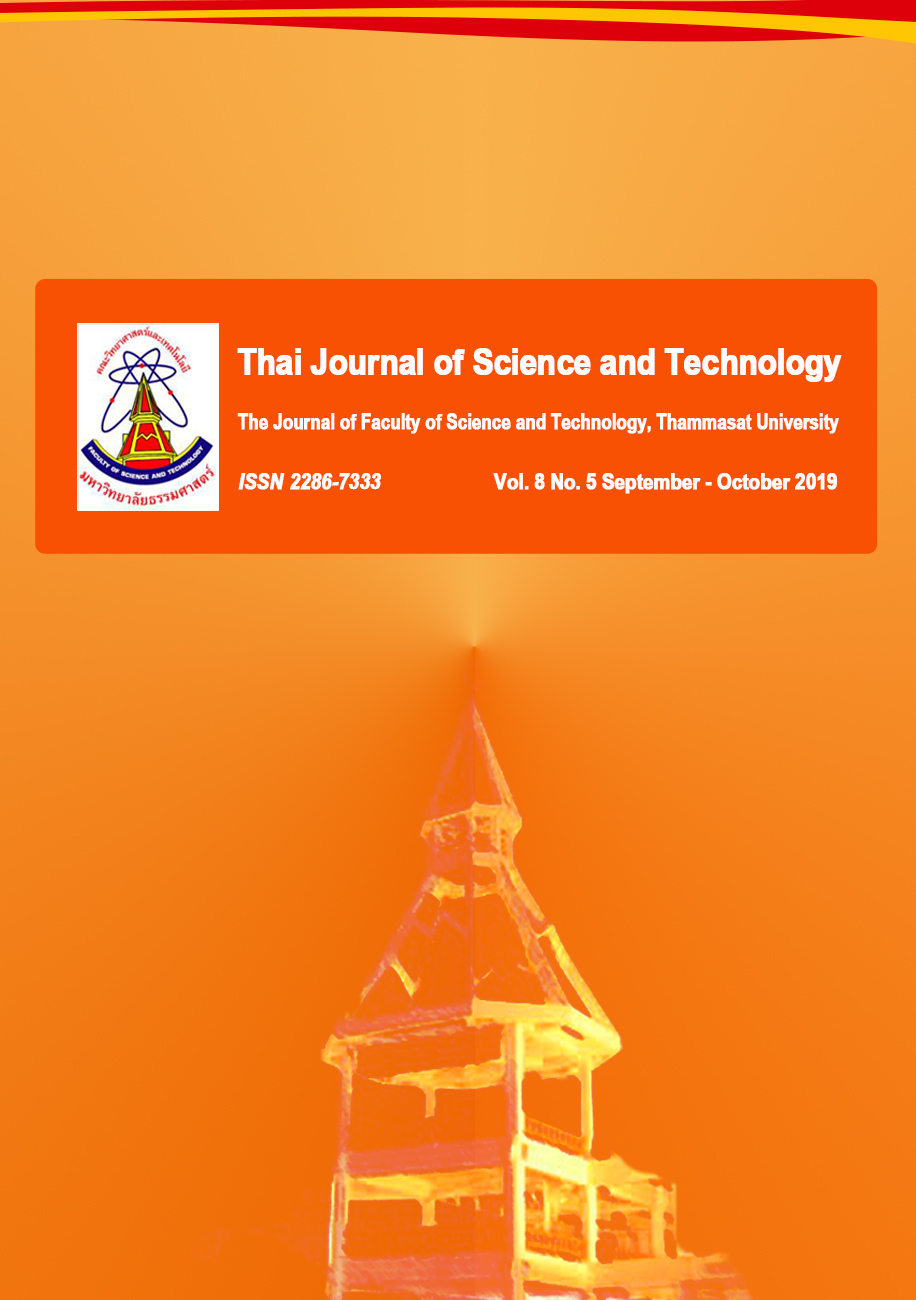การคัดแยกแบคทีเรียจากน้ำย้อมครามในหม้อย้อมและดินบริเวณย้อมครามเพื่อประยุกต์ใช้ในการย้อมและบำบัดน้ำเสีย
Main Article Content
บทคัดย่อ
บทคัดย่อ
การคัดแยกและระบุชนิดแบคทีเรียจากน้ำสีย้อมครามในกระบวนการย้อมผ้าครามธรรมชาติและดินบริเวณย้อม เพื่อนำแบคทีเรียที่ได้ไปประยุกต์ใช้ในการย้อมและลดสีในน้ำเสีย สามารถคัดแยกแบคทีเรียได้ 23 ไอโซเลต เมื่อระบุชนิดแบคทีเรียโดยใช้ลักษณะสัณฐานและวิเคราะห์ลำดับนิวคลีโอไทด์ของยีน 16S rRNA พบว่าแบคทีเรียที่คัดแยกได้จัดอยู่ใน 5 สกุล ได้แก่ Bacillus 15 ไอโซเลต Pseudomonas 4 ไอโซเลต Acinetobacter 2 ไอโซเลต Lysinibacillus 1 ไอโซเลต และ Aerococcus 1 ไอโซเลต จากการศึกษาเบื้องต้น พบว่าแบคทีเรียที่คัดแยกได้จากน้ำสีย้อมสามารถเปลี่ยนรูปอินดิแคนเป็นอินดอกซิลและกลูโคส โดยแบคทีเรีย Bacillus kochii SKTU 5 สามารถให้ปริมาณกลูโคสสูงสุดเท่ากับ 63.67±6.59 มิลลิโมลาร์ ที่อุณหภูมิ 30 องศาเซลเซียส ระยะเวลา 96 ชั่วโมง อย่างไรก็ตาม สำหรับ Acinetobacter baumannii SKBT 2 ซี่งเป็นแบคทีเรียที่แยกได้จากดินที่บริเวณย้อมครามลดสีครามได้ 79.13±0.43 เปอร์เซ็นต์ ที่ความเข้มข้นเริ่มต้นของสี indigo ที่ 25 มิลลิกรัมต่อลิตร ภายใต้สภาวะนิ่ง อุณหภูมิ 37 องศาเซลเซียส ในระยะเวลา 48 ชั่วโมง ผลจากการวิจัยนี้สามารถนำไปต่อยอดเพื่อพัฒนาเป็นหัวเชื้อสำหรับกระบวนการย้อมและลดสีในน้ำเสียจากการย้อมครามต่อไป
คำสำคัญ : กระบวนการย้อมผ้าครามจากสีธรรมชาติ; การย้อมสีคราม, การลดสี; สีคราม; ยีน 16S rRNA
Article Details
บทความที่ได้รับการตีพิมพ์เป็นลิขสิทธิ์ของคณะวิทยาศาสตร์และเทคโนโลยี มหาวิทยาลัยธรรมศาสตร์ ข้อความที่ปรากฏในแต่ละเรื่องของวารสารเล่มนี้เป็นเพียงความเห็นส่วนตัวของผู้เขียน ไม่มีความเกี่ยวข้องกับคณะวิทยาศาสตร์และเทคโนโลยี หรือคณาจารย์ท่านอื่นในมหาวิทยาลัยธรรมศาสตร์ ผู้เขียนต้องยืนยันว่าความรับผิดชอบต่อทุกข้อความที่นำเสนอไว้ในบทความของตน หากมีข้อผิดพลาดหรือความไม่ถูกต้องใด ๆ
เอกสารอ้างอิง
นฤมล ธนานันต์, นวัฒน์ เกตุสวัสดิวงศ์, ศรีสุดา ปัณณานุสรณ์ และธีระชัย ธนานันต์, 2559, การระบุชนิดของแบคทีเรียกรดแลคติกที่แยกได้จากน้ำพริกด้วยลำดับนิวคลีโอไทด์ของยีน 16S rRNA, Thai J. Sci. Technol. 5(2): 160-168.
ปิยวรรณ กลมเกลี้ยง, ธีระชัย ธนานันต์, นิรมล ศากยวงศ์ และสายัณห์ สมฤทธิ์, 2557, ผลการจำแนกราด้วยวิธีไอทีเอสพีซีอาร์และความ สามารถในการบำบัดสีรีแอคทีฟ RR141, ว.วิทยาศาสตร์และเทคโนโลยี 22(5): 683-694.
พิชญาพร ภิญญ์ญาพัช, ธวัชชัย ชัยธวัชวิถี และเอกอาทิตย์ ฤทธิเดชยิ่ง, 2561, การคัดแยกและการระบุสายพันธุ์เชื้อจุลินทรีย์เพื่อการผลิตสีย้อมห้อมแบบธรรมชาติ, ว.วิจัยและส่งเสริมวิชาการเกษตร 35(1): 45-54.
สมพงศ์ โอทอง และเบญจวรรณ บัวขวัญ, 2556, การพัฒนากล้าเชื้อจุลินทรีย์เพื่อใช้ในกระบวนการหมักสีครามจากต้นครามและการเก็บรักษาสีครามในสภาพเหมาะสมต่อการย้อม, รายงานวิจัยโครงการส่งเสริมการวิจัยในอุดมศึกษาและพัฒนามหาวิทยาลัยวิจัยแห่งชาติ, มหาวิทยาลัยทักษิณ, สงขลา, 65 น.
อนุรัตน์ สายทอง, 2555, ไหมย้อมครามธรรมชาติ, ว.วิทยาศาสตร์ มข. 40(2): 423-435.
Aino, K., Narihiro, T., Minamida, K., Kamagata, Y., Yoshimune, K. and Yumoto, I., 2010, Bacterial community characterization and dynamics of indigo fermentation, FEMS Microbiol. Ecol. 74: 174-183.
Campos, R., Kandelbauer, A., Robra, K.H., Cavaco-Paulo, A. and Gubitz, G.M., 2001, Indigo degradation with purified laccases from Trametes hirsuta and Sclerotium rolfsii, J. Biotechnol. 89: 131-139.
Clark, R.J.H., Cooksey, C.J., Daniels, M.A.M. and Withnall, R., 1993, Indigo, woad, and Tyrian Purple: Important vat dyes from antiquity to the present, Endeavour 17: 191-199.
Heuer, H., Krsek, M., Baker, P., Smalla, K. and Wellington, E.M., 1997, Analysis of actinomycete communities by specific amplification of genes encoding 16S rRNA and gel-electrophoretic separation in denaturing gradient, Appl. Environ. Microbiol. 63: 3233-3241.
Li, H.X., Xu, B., Tang, L., Zhang, J.H. and Mao, Z.G., 2015, Reductive decolorization of indigo carmine dye with Bacillus sp. MZS10, Int. Biodeterior. Biodegrad. 103: 30-37.
Minami, Y., Takao, H., Kanafuji, T., Miura, K., Kondo, M., Hara Nishimura, I. and Matsubara, H., 1997, bata-glucosidase in the indigo plant: Intracellular localization and tissue specific expression in leaves, Plant. Cell. Physiol. 38: 1069-1074.
Ramya, M., Anusha, B. and Kalavathy, S., 2008, Decolorization and biodegradation of indigo carmine by a textile soil isolate Paeni bacillus larvae, Biodegradation 19: 283-291.
Schmidt, H., 1997, Indigo-100 Jahre industrielle Synthese, Chemie in unserer Zeit 31: 121-128.
Song, J., Imanaka, H., Imamura, K., Kajitani, K. and Nakanishi, K., 2010, Development of a highly efficient indigo dyeing method using indican with an immobilized beta-glucosidase from Aspergillus niger, J. Biosci. Bioeng. 110: 281-287.


